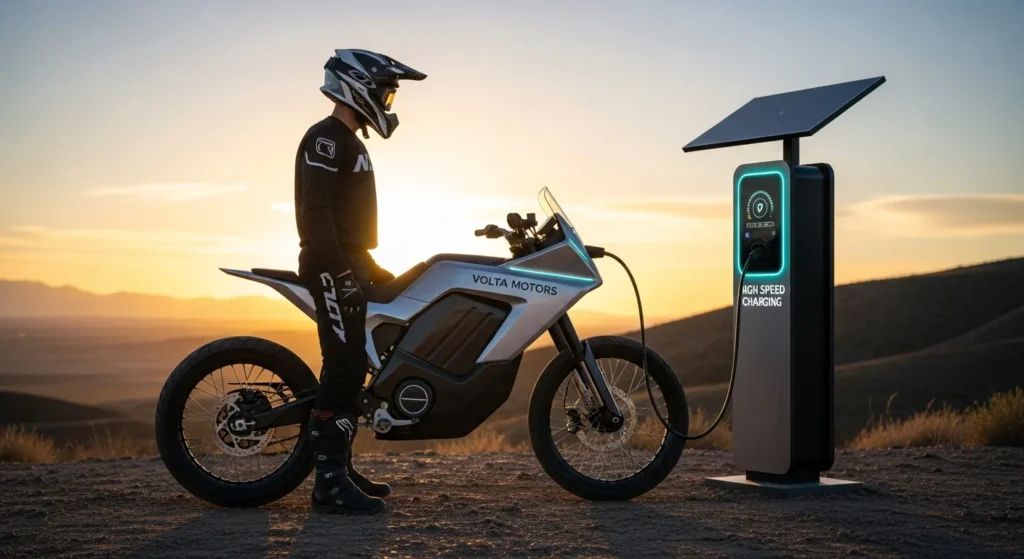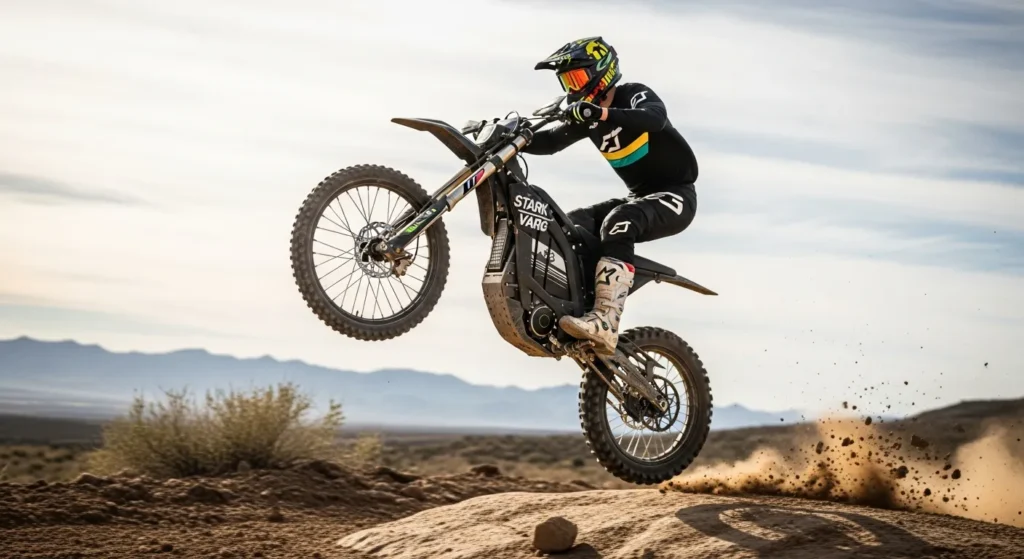Something’s shifting in the motorcycle world — and it’s not just the hum of electric motors. Out on the trails, where the air smells like dust and pine, where every throttle twist matters, riders are starting to talk about a new kind of power. A promise, almost.
The promise that you could add 100 kilometers of range in just 10 minutes.
Sounds wild, doesn’t it? But it’s happening.
[IMAGE: Rider standing beside an electric dirt bike plugged into a fast charger at sunset]
Until recently, electric motorcycles — especially off-road and adventure bikes — came with that nagging limitation: great torque, terrible wait time. You could ride like a maniac for a few hours, but when the battery hit zero, your day was pretty much done. Grab a coffee, maybe two, while the bike sipped electrons back into life.
Now, though, the script is flipping.
Why Everyone’s Suddenly Talking About Ultra-Fast Charging
Electric bikes have always nailed instant torque. That snappy, immediate pull you feel the moment you twist the throttle? Pure magic. But ask any trail rider or adventure junkie what stops them from switching fully electric — you’ll hear the same thing every time: charging and range.

Range anxiety is real, especially when your route includes deep forest trails or mountain climbs. You don’t want to be halfway up a ridge wondering if your battery will make it back.
But in the past year, battery technology has been sprinting forward — and what used to sound like a marketing stunt is now backed by solid engineering.
Take BBM’s Hiro, for instance — a European electric motorcycle that claims to add 100 km of range in just 9 minutes. Yep, nine.
That’s roughly the time it takes to grab a drink, stretch your legs, and check your messages before hopping back on the bike.
This new wave of tech is powered by advanced lithium-titanate chemistry and higher-voltage charging systems (think 360 V+ architectures). These setups don’t just refill faster — they do it with less heat and less battery wear.
So for 2026, the big question isn’t if ultra-fast charging will land. It’s which brands will nail it first, and how it’ll reshape the way we ride.
The Game-Changer: When Charging Becomes a Pit Stop, Not a Pause
Picture this. You’re deep in the backcountry, tires kicking up dust, the trail curving into the horizon. You pull into a small staging area, plug in your bike, grab a quick snack — and by the time you’ve stretched your shoulders, you’re ready to roll again.
That’s the vision behind ultra-fast charging. A 10-minute break that replaces a 2-hour stop.

It changes the rhythm of a ride. You’re no longer thinking in loops and range circles; you’re thinking in routes and hours.
You can chase that distant ridge, explore longer trails, and stay out past sunset knowing that if you find a high-power charger nearby, you’re back in business in minutes.
Of course, there’s fine print.
You’ll need DC fast chargers capable of pushing big watts — the same kind you’d find at EV car stations.
Heat management, cable standards, and battery health all play roles. But conceptually, the walls that once boxed in electric riding are starting to crumble.
Which 2026 Models Already Deliver Ultra-Fast Recharge?
Let’s talk specifics — the bikes that are actually pushing this frontier. Because this isn’t vaporware anymore. Some brands are already demonstrating what the “100 km in 10 minutes” reality looks like.
1. BBM Hiro — The European Pioneer

The BBM Hiro might just be the first production-ready motorcycle to make that magic 9-minute recharge real.
Born out of Spain’s Basque region, the Hiro platform blends European design with next-gen battery innovation.
- Charging: 100 km range in about 9 minutes
- Battery: 12.96 kWh, 360 V architecture
- Power: 94 hp, 150 Nm torque
- Top speed: 190 km/h (118 mph)
What’s clever about the Hiro is its modular lineup — the same base tech appears in multiple styles: Streetfighter, Roadster, Café Racer, and even a Scrambler-inspired version that edges into off-road territory.
The Hiro’s charging system uses high-power DC connectivity (CCS2) — meaning if you can find a compatible charger, you’ll be rolling again before your buddies have even finished their energy bars.
For trail and adventure riders, this sets a new psychological baseline: fast charging isn’t theoretical anymore — it’s here.
2. Yadea Kemper — The Urban Speed Demon

The Yadea Kemper comes from a brand better known for scooters, but don’t let that fool you. This thing charges from 0 to 80% in about 10 minutes, thanks to its 320 V battery system.
- Charging: 0–80% in 10 minutes
- Battery: 6.4 kWh
- Top speed: 160 km/h (99 mph)
It’s not a dirt-focused bike, more of an urban performance model, but its charging claims show where the industry is heading.
If a commuter-grade machine can fast-fill in 10 minutes, then adventure and off-road models won’t be far behind.
And here’s the key insight: when a major manufacturer like Yadea builds a mass-market motorcycle with fast-charge support, it pressures the entire industry to adapt.
Think of it as a proof of concept that scales — what’s born in the city will soon live on the trails.
3. Stark Future Varg — The Trail Benchmark

You can’t talk about electric dirt bikes without mentioning the Stark Varg.
It’s already a legend — arguably the most powerful production dirt bike ever built, electric or not.
- Power: 80 hp
- Torque: 938 Nm (rear wheel)
- Range: Up to 6 hours of trail riding
- Charging: Currently 1–2 hours (fast-charging coming soon)
The Varg isn’t at the “10-minute top-up” level yet, but it sets the performance benchmark for what’s coming.
Its battery and controller architecture are built to support faster DC charging once the next firmware and hardware updates roll out.
And unlike most street-oriented electric motorcycles, the Varg was designed from the ground up for dirt — meaning it’s rugged, balanced, and built to survive abuse from serious riders.
So while the Hiro and Kemper show what’s possible on paper, the Stark Varg represents the real-world base camp — the kind of machine that could soon make 10-minute charging on the trail feel normal.
What This Means for Weekend Riders
If you’re like most of us — a weekend warrior, a trail junkie, a rider who chases dust until sundown — this new tech changes your game entirely.
No more staring at the charge gauge wondering if you can finish your route.
No more sitting around for two hours waiting for your bike to sip back a few miles of juice.
With ultra-fast charging, the riding mindset shifts from “Can I make it?” to “How far can I go today?”

I’ve spent enough time on both petrol and electric bikes to say this: convenience is everything.
The more seamless the experience feels — the more it mimics the rhythm of gas refueling — the more likely riders are to switch.
And psychologically, it makes a big difference. Ten minutes is a break.
Two hours is a delay.
That subtle shift could be what finally pushes electric bikes into mainstream off-road culture.
Comparing the Numbers: Electric vs. Petrol
Let’s put it side by side.
| Feature | Petrol Dirt Bike | Current Electric (2024) | Ultra-Fast Electric (2026 target) |
|---|---|---|---|
| Refuel / Recharge time | 3–5 minutes | 1–2 hours | ~10 minutes |
| Range per fill/charge | 120–180 km | 80–150 km | 150–200 km |
| Maintenance | High | Low | Low |
| Noise | Loud | Quiet | Quiet |
| Torque delivery | Linear | Instant | Instant |
That’s where the story clicks: the gap between petrol and electric is closing, fast.
Once charging drops below 15 minutes, you’ve basically equaled the convenience of a fuel stop — without oil changes, valve checks, or carb cleanings.
Should You Wait or Buy Now?
Here’s the honest truth.
If you’re a rider who spends your weekends looping around local trails, you can buy an electric bike now and be happy.
Models like the Stark Varg or KTM Freeride E-XC already offer a solid few hours of pure off-road fun.
But if your rides stretch long — multi-hour loops, remote trails, desert crossings — then it might be worth waiting for the 2026 wave of ultra-fast chargers.
Because “100 km in 10 minutes” isn’t a myth anymore — it’s a matter of infrastructure catching up.
And that’s the key: the charger network.
As public fast-charging points multiply, electric dirt bikes will finally stop feeling like experimental tech and start feeling like just… bikes.
The Future: More Ride Time, Less Wait Time
Imagine this:
You finish a tough descent, the bike hums quietly, dust settling around your boots.
You plug it in, take a sip of water, scroll your phone, chat with friends — and ten minutes later, your machine is ready to roar again.
That’s the future of off-road riding.
No noise, no fumes, no compromises. Just pure throttle and freedom.
For rental fleets, tour companies, or casual riders, it’s a win-win.
More uptime, less maintenance, and more smiles per mile.
And for riders like us — the ones who live for the trail — it’s not just about charging faster.
It’s about staying in the zone longer.
Because at the end of the day, the less time your bike spends plugged in, the more time it spends doing what it was built for: riding.
Final Thoughts
The “100 km in 10 minutes” era isn’t just a technical milestone — it’s a cultural shift.
It blurs the line between the mechanical and the digital, the traditional and the electric.
Brands like BBM, Yadea, and Stark Future are showing the roadmap.
And when these technologies finally meet in the middle — lightweight frames, fast batteries, rugged terrain — that’s when electric riding will stop being the future… and simply become the present.
